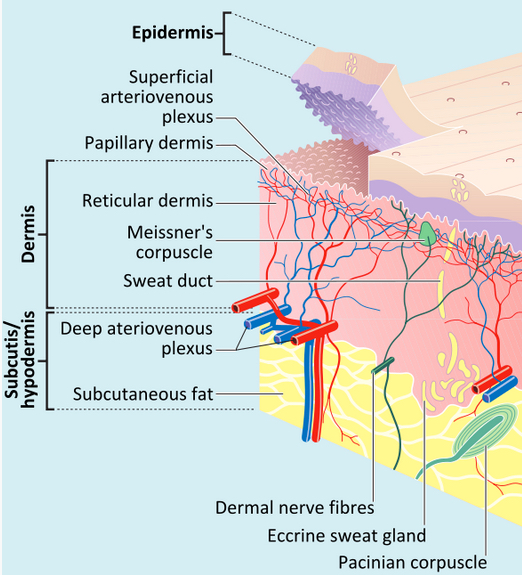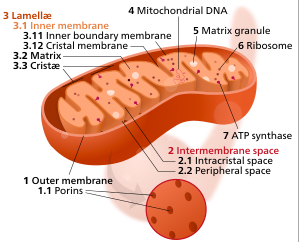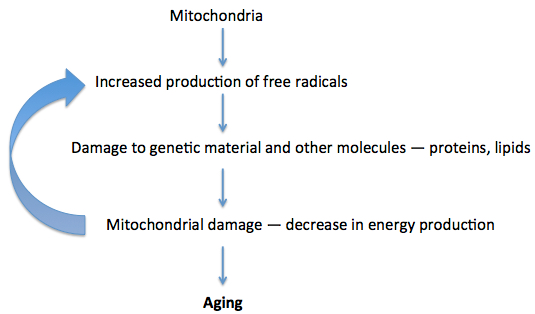Human-skin discovery suggests new anti-aging treatments
March 4, 2016

Layers in hairless skin (credit: Madhero88 and M.Komorniczak/Creative Commons)
For the first time, researchers have reported decreases in levels of a key molecule in aging human skin, which could lead to developing new anti-aging treatments and screening new compounds.

Components of a typical mitochondrion (credit: Kelvinsong/Creative Commons)
Scientists have known for some time that major structures in the cell called mitochondria (which generate and control most of the cell’s supply of energy) are somehow involved in aging, but the exact role of the mitochondria has remained unclear.
The longstanding “mitochondrial free radical theory of aging,” originally proposed by Professor Denham Harman in 1972, is currently the most widely accepted theory of aging. It proposes that mitochondria contribute to aging by producing free radicals — chemicals that can damage our genetic material and other molecules and so accelerate aging. Free-radical production increases lead to a cycle of further damage and further increases in free radicals.

Mitochondrial free radical theory of aging (credit: Julie Milland)
However, Mark Birch-Machin, PhD, professor of Molecular Dermatology at Newcastle University’s Institute of Cellular Medicine and senior author of an open-access article in the Journal of Investigative Dermatology, now reports a new research finding: a protein in mitochondria called mitochondrial complex II (a key complex for production of energy) decreases with age in human skin. (Further studies are needed to understand whether that decrease actually causes skin aging, or is a result of skin aging, or is otherwise correlated.)
The researchers also found that levels of mitochondrial complex II decrease in the deeper layers of aging human skin.*
Anti-aging treatments and cosmetic products
Birch-Machin says this new discovery brings experts a step closer to developing anti-aging treatments and cosmetic products that could counteract this decrease in mitochondrial complex II in aging human skin, and treatment could even be “tailored to differently aged and differently pigmented skin.”
The findings may also lead to a greater understanding of aging in other parts of the body, and this could pave the way for drug development in a number of age-related diseases, including cancer.
Funding was provided by the North Eastern Skin Research Fund, the NIHR Biomedical Research Centre at Newcastle University and Newcastle Upon Tyne Hospitals NHS Foundation Trust, and Newcastle University’s Faculty of Medical Sciences.
* To test the activity of mitochondrial complex II, skin samples were taken from a sun-protected area of skin from 27 people aged six to 72 years. The mitochondrial complex II activity was measured in keratinocyte cells from the upper layer of skin (epidermis) and in fibroblast cells from the deeper levels of skin (dermis). The researchers found that mitochondrial complex II activity significantly decreased with age in the fibroblast cells from the deeper skin layer, but not in the keratinocytes from the upper layer of skin. The mitochondrial complex II activity decreased because less of the protein was being synthesized and the decrease was only observed in those cells that had stopped multiplying.
Abstract of Age-Dependent Decrease of Mitochondrial Complex II Activity in Human Skin Fibroblasts
The mitochondrial theory of aging remains one of the most widely accepted aging theories and implicates mitochondrial electron transport chain dysfunction with subsequent increasing free radical generation. Recently, complex II of the electron transport chain appears to be more important than previously thought in this process, suggested predominantly by nonhuman studies. We investigated the relationship between complex II and aging using human skin as a model tissue. The rate of complex II activity per unit of mitochondria was determined in fibroblasts and keratinocytes cultured from skin covering a wide age range. Complex II activity significantly decreased with age in fibroblasts (P = 0.015) but not in keratinocytes. This was associated with a significant decline in transcript expression (P = 0.008 and P = 0.001) and protein levels (P = 0.0006 and P = 0.005) of the succinate dehydrogenase complex subunit A and subunit B catalytic subunits of complex II, respectively. In addition, there was a significant decrease in complex II activity with age (P = 0.029) that was specific to senescent skin cells. There was no decrease in complex IV activity with increasing age, suggesting possible locality to complex II.